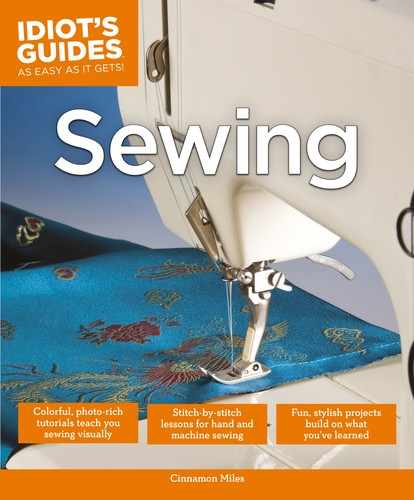
158 Part 3: More Techniques
Using Interfacing
What Is It Used For?
Interfacing is applied to a layer of fabric to add shape, support, structure, or firmness to collars, cuffs,
waistbands, and pockets. It is also used to stiffen fabrics used in craft projects, such as purses or fabric
boxes.
Interfacing comes in two types: fusible and sew-in. Each type has varying weaves—knit, woven, and
nonwoven—and can be light, medium, or heavy in weight. Interfacing is usually found in white/cream
orblack.
Fusible Woven Medium-
Weight Plush
Sew-In Woven
Medium Weight
Fusible Knit Tricot
Fusible Nonwoven
Midweight
Fusible Woven 100%
Cotton Lightweight
Fusible Nonwoven
Heavyweight
ooCH11_Sewing.indd 158 5/23/13 3:39 PM

159Chapter 11: Basic Clothing Techniques
How Do You Choose the Right Type?
When you’re sewing with a pattern, it will usually
specify the type, weave, and weight of interfacing
required, so be sure to read the instructions
thoroughly.
The weight of sewn-in interfacing should be the
same as the fabric—for example, medium-weight
fabric would use medium-weight interfacing. The
intended use also determines the weight you
need—a cuff may need a stiffer interfacing than a
floppy-style collar, for instance.
Always choose knit interfacing for knit fabrics.
This includes stretch fabrics and jersey knits,
where it’s necessary to have the interfacing
stretch with the fabric.
Nonwoven interfacing is all purpose and can be
cut in any direction, so it is the most economical
form of interfacing. It can pretty much be used
on any woven fabric except for something sheer,
like silk.
Like fabric, woven interfacing has a lengthwise
and crosswise grain and needs to be cut in the
same direction as the fabric it is being used with.
For best results, use dark-colored interfacing
with dark fabrics and the white or natural-colored
interfacing with light fabrics.
Fusible interfacing is the easiest to use and will
work with most fabrics. It has a textured side with
glue applied to it. It is heat activated, so all you
have to do is place the interfacing textured side
down on the wrong side of the fabric and press
it with a hot iron to heat up the glue and fuse or
bond it to the fabric. You shouldn’t use fusible
interfacing on a fabric that can’t be ironed at a
high heat or a heavily textured fabric, because
it won’t stay fused. It also shouldn’t be used on
something like lace, because the glue will leave a
residue on the front side of the fabric.
Read the directions that come with your fusible
interfacing; each weight and type will have
specific instructions related to heat and the time
it takes to bond. Generally, you will press the
fusible interfacing in sections by picking up the
iron and setting it back down. You won’t slide
the iron around, because doing so may shift the
layers. You’ll also want to use a pressing cloth
to protect the surface of the iron from any glue
residue.
Sew-in interfacing is applied by being sewn to the
fabric layer and is less commonly used than the
fusible type.
ooCH11_Sewing.indd 159 5/23/13 3:39 PM
..................Content has been hidden....................
You can't read the all page of ebook, please click here login for view all page.
